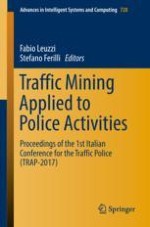This book presents high-quality original contributions on the development of automatic traffic analysis systems that are able to not only anticipate traffic scenarios, but also understand the behavior of road users (vehicles, bikes, trucks, etc.) in order to provide better traffic management, prevent accidents and, potentially, identify criminal behaviors. Topics also include traffic surveillance and vehicle accident analysis using formal concept analysis, convolutional and recurrent neural networks, unsupervised learning and process mining. The content is based on papers presented at the 1st Italian Conference for the Traffic Police (TRAP), which was held in Rome in October 2017. This conference represents a targeted response to the challenges facing the police in connection with managing massive traffic data, finding patterns from historical datasets, and analyzing complex traffic phenomena in order to anticipate potential criminal behaviors. The book will appeal to researchers, practitioners and decision makers interested in traffic monitoring and analysis, traffic modeling and simulation, mobility and social data mining, as well as members of the police.
